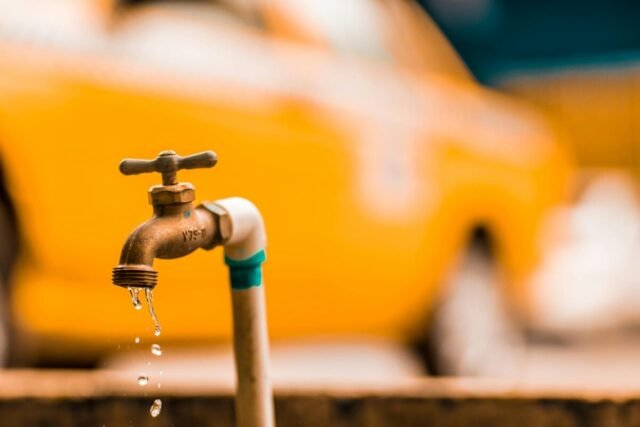A leaky pipe is a common household problem that can quickly escalate into a major issue if not addressed promptly. Whether it's a slow drip or a steady stream, a water leak can cause extensive damage to your home, leading to mold growth, structural damage, and exorbitant water bills. While calling a professional plumber is always an option, many leaks can be fixed with some basic DIY plumbing skills and the right tools. This comprehensive guide will walk you through the process of pipe leak repair, helping you save money and resolve the issue quickly. However, it's essential to know when a leak is beyond your skill level and requires the expertise of a professional plumber.
Identifying the Source of the Leak
The first and most crucial step in fixing a leaky pipe is to determine the type and location of the leak. Common leak locations include:
- Under sinks
- Behind toilets
- Within walls
- Near water heaters
- In basement or crawl space pipes
Some leaks are easy to spot, such as a dripping faucet or a puddle near a pipe, while others may require more investigation. Types of pipe leaks include:
- Pinhole leaks: These are tiny holes caused by corrosion, high water pressure, or age. They can be difficult to locate but often cause significant water damage over time.
- Hairline cracks: These thin, spiderweb-like fractures in the pipe can be caused by sudden temperature changes, impact damage, or general wear and tear.
- Loose connections: When the joint between two pipes becomes loose or deteriorates, it can allow water to escape.
- Corroded pipes: Over time, pipes can corrode from the inside out, leading to leaks and eventual pipe failure.
To locate a hidden leak, look for signs such as:
- Water stains on walls, ceilings, or floors
- Bulging or sagging walls
- Unexplained dampness or mold growth
- The sound of running water when no taps are open
- A musty smell or visible mildew
- Unusually high water bills
Effective pipe leak detection is crucial for a successful repair. If you're having trouble locating the leak, consider using a moisture meter or calling a professional plumber for assistance.
Essential Tools and Materials for Leaky Pipe Repair
Having the right plumbing tools and leak repair materials on hand can make your DIY plumbing project much smoother. Here's a comprehensive list of what you'll need for most basic repairs:
Tools:
- Pipe wrench: Used for gripping and turning pipes and fittings
- Adjustable wrench: Versatile tool for tightening or loosening nuts and bolts
- Pliers: Useful for gripping and holding small parts
- Utility knife: Helps in cutting pipe repair tape and removing old putty or debris
- Bucket: Catches water during the repair process
- Rags or paper towels: For cleaning and drying the repair area
- Flashlight: Helps illuminate dark or hard-to-reach areas
- Hacksaw: Used for cutting pipes if needed
Materials:
- Pipe repair tape (Teflon tape): Creates a watertight seal on threaded connections
- Epoxy putty: A moldable, waterproof sealant for patching holes and cracks
- Pipe clamps: Used to secure a patch or repair in place
- Replacement pipe sections and fittings: In case a section of pipe needs to be replaced entirely
- Sandpaper or emery cloth: For smoothing rough edges or preparing surfaces for repair
Don't forget safety gear like gloves and goggles to protect yourself during the repair process. If you're dealing with a more complex repair or unfamiliar materials, consult a professional plumber or a home improvement store associate for guidance.
Step-by-Step Guide to Fixing a Leaky Pipe
Once you've identified the leak and gathered your tools and materials, it's time to start your pipe leak repair. Follow these detailed steps for a successful DIY plumbing repair:
-
Turn off the water supply: Locate the main water valve and turn it off completely. This is usually located near the water meter or where the main water line enters your home. If you can't find the main valve, turn off the valve closest to the leaky pipe.
-
Drain the pipe: Open the faucet closest to the leak to drain any remaining water from the pipe. This will help prevent water from spilling out during the repair process. Place a bucket under the leak to catch any residual water.
-
Clean and prepare the leak area: Use a utility knife or sandpaper to remove any old tape, putty, or debris from around the leak. Clean the pipe thoroughly with a rag or emery cloth to ensure the repair material adheres properly.
-
Apply the appropriate repair method:
- For pinhole leaks: Apply epoxy putty to the hole, molding it around the pipe to create a seal. Follow the manufacturer's instructions for mixing and curing times. For extra reinforcement, wrap pipe repair tape around the putty once it has partially cured.
- For hairline cracks: Wrap pipe repair tape around the crack, starting at one end and overlapping each layer by half. Continue wrapping until the crack is completely covered, extending the tape a few inches on either side of the damage. Smooth the tape to remove any air bubbles and ensure a tight seal.
- For loose connections: Tighten the connection with a pipe wrench, being careful not to over-tighten and damage the fitting. If the joint is severely damaged or continues to leak after tightening, you may need to replace the fitting entirely.
-
Test for leaks: Turn the water supply back on slowly and check for any leaks around the repair. If the repair holds, allow the putty or tape to cure fully according to the manufacturer's instructions. If you notice any leaks, turn the water off immediately and repeat the repair process.
-
Reconnect the water supply: Once the repair is complete and fully cured, turn the main water valve back on and check for leaks one final time. Run the nearest faucet for a few minutes to flush out any debris and ensure proper water flow.
When to Call a Professional Plumber
While many leaky pipe issues can be resolved with DIY plumbing, some situations call for an emergency plumber or professional plumbing services. If you encounter any of the following, it's best to leave the plumbing leak repair to the experts:
- Major leaks or burst pipes: Large-scale leaks can cause significant damage quickly and often require specialized tools and expertise to repair.
- Gas line leaks: If you smell gas or suspect a gas line leak, evacuate the area immediately and call your gas company or a professional plumber. Gas leaks can be extremely dangerous and should never be attempted as a DIY repair.
- Leaks in hard-to-reach areas or within walls: Accessing and repairing leaks behind walls, under foundations, or in tight spaces can be challenging and may require special equipment or techniques.
- Lack of proper tools or plumbing knowledge: If you don't feel confident in your ability to complete the repair safely and effectively, it's best to call a professional.
- Persistent leaks that you've attempted to fix unsuccessfully: If you've tried to repair a leak multiple times without success, there may be an underlying issue that requires professional diagnosis and repair.
When hiring a plumber, be sure to:
- Check online reviews and ratings: Look for a plumber with a strong reputation and positive customer feedback.
- Get multiple quotes for the job: Compare prices and services from several plumbers to ensure you're getting a fair deal.
- Ask for references and proof of licensing and insurance: A reputable plumber should be willing to provide references and proof of their qualifications and insurance coverage.
- Clarify the scope of work and pricing: Make sure you understand exactly what repairs will be performed and how much they will cost before agreeing to any work.
Preventing Future Leaks
Regular pipe maintenance and leak prevention measures can help you avoid the hassle and expense of leaky pipe repair. Some tips for keeping your pipes in top shape include:
- Insulating pipes in cold areas: Pipes in unheated areas like attics, basements, and exterior walls are prone to freezing and bursting in cold weather. Insulate these pipes with foam sleeves or wrap to prevent damage.
- Monitoring water pressure: High water pressure can strain your pipes and lead to leaks over time. If you suspect high water pressure, have a plumber install a pressure reducer valve to maintain a safe level.
- Fixing small leaks promptly: Don't ignore small leaks or drips, as they can quickly worsen and cause more extensive damage. Address any leaks as soon as you notice them to prevent further issues.
- Avoiding chemical drain cleaners: While chemical drain cleaners can be tempting for clearing clogs, they can also damage your pipes over time. Opt for gentler methods like plunging, snaking, or enzymatic cleaners instead.
- Scheduling annual plumbing inspections: Having a professional plumber inspect your plumbing system once a year can help catch potential issues early and prevent major leaks or failures.
| Leak Prevention Checklist | Frequency |
|---|---|
| Check for visible leaks and signs of water damage | Monthly |
| Test water pressure and install a pressure reducer if needed | Annually |
| Insulate pipes in unheated areas | Before winter |
| Schedule a comprehensive plumbing inspection | Annually |
| Clean and maintain drains and fixtures | Quarterly |
| Replace washing machine hoses | Every 3-5 years |
| Locate and label main water shut-off valve | As needed |
By following this checklist and staying proactive about pipe maintenance, you can minimize the risk of leaks and extend the life of your plumbing system.
Dealing with a leaky pipe can be stressful and overwhelming, but with the right knowledge, tools, and DIY plumbing skills, many leaks can be repaired quickly and effectively. By following the steps outlined in this guide and addressing water leaks promptly, you can minimize damage to your home and save money on costly plumbing repairs.
However, it's crucial to recognize when a leak is beyond your skill level and requires the expertise of a professional plumber. Don't hesitate to call for help if you encounter a major leak, gas line issue, or persistent problem that you can't resolve on your own.
Remember, the key to avoiding leaks and maintaining a healthy plumbing system is prevention. By implementing regular pipe maintenance tasks and addressing small issues before they escalate, you can save yourself time, money, and stress in the long run. With these plumbing tips, a proactive mindset, and a trusted plumber on speed dial, you'll be well-equipped to handle any leaky pipe challenges that come your way.































